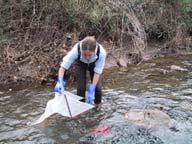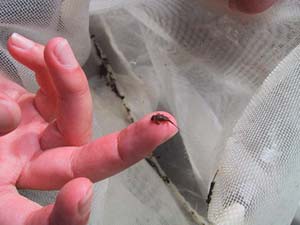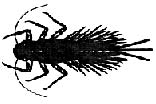

Aquatic insects are a vital facet of most freshwater and marine ecosystems. Many terrestrial insects begin their lives in the water, respiring with the aid of filamentous gills. Within an aquatic environment, the abundance of small invertebrates are an important food item for many species of fish. The presence or absence of several families of aquatic insects are also a reliable indicator of water quality.
Aquatic invertebrates often live grasping on to rocks or within the bottom sediment of the river benthos.
We are able to collect these insects by scrubbing rocks and allowing the flow of the river to force the organisms into a basket-like net called a Surber sampler (pictured above).

Order: Ephemeroptera

Mayflies
Order: Plecoptera

Stoneflies
Order: Trichoptera
![]()
Caddisflies
Mayflies, stoneflies and caddisflies are representative of aquatic insects that may be found in some areas of the Smith River. Mayflies and and Stoneflies clasp on to rocks in areas of fast moving water. By locating themselves near moving water, these insects have a constant supply of oxygenated water moving past their gills, thus enabling respiration.
Interestingly, many species of caddisflies build cases (pictured above) made of small pebbles or twigs and other organic matter. These cases are often found attached to rocks and provide camouflage and protection from predators.
Ephemeroptera, Plecoptera and Trichoptera are very sensitive to water quality, which include both chemical and temperature attributes. For this reason, the health of a fluvial system may be judged by determining the presence and abundance of these insects. An adequate abundance of representatives from each of the three orders often indicate satisfactory water quality.